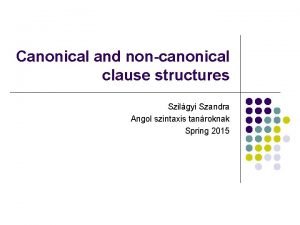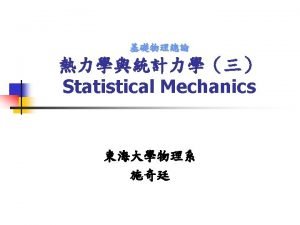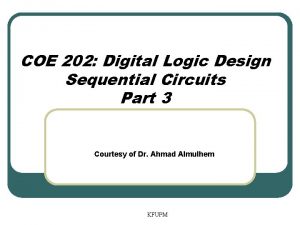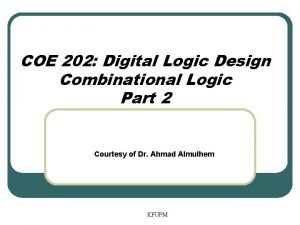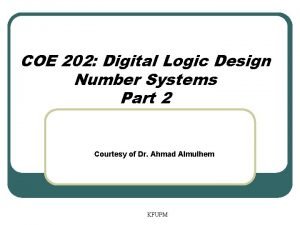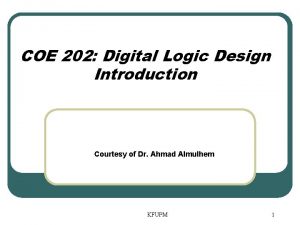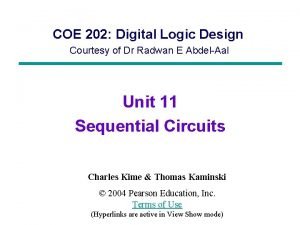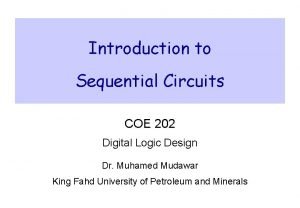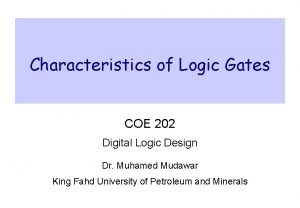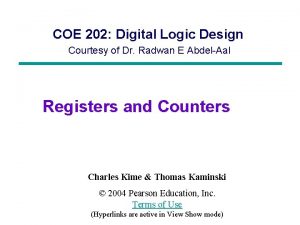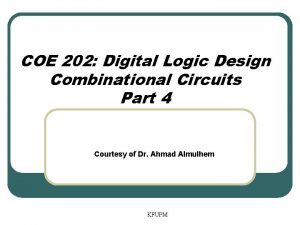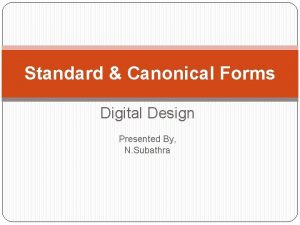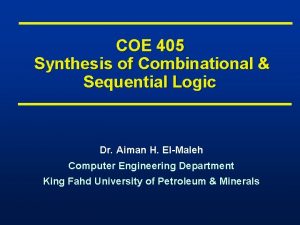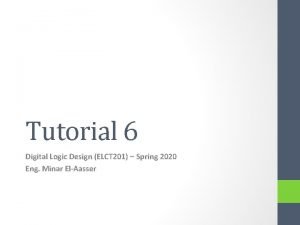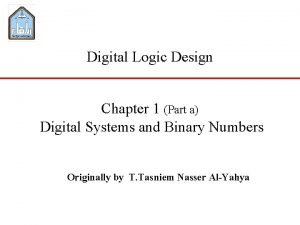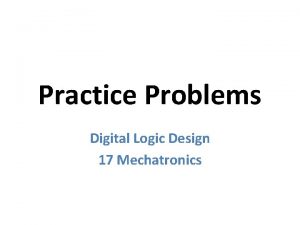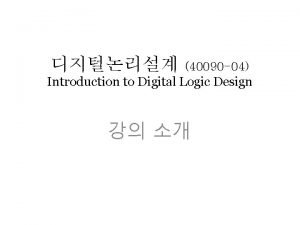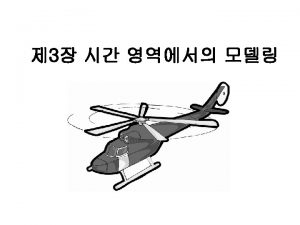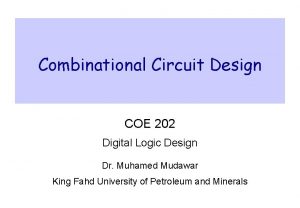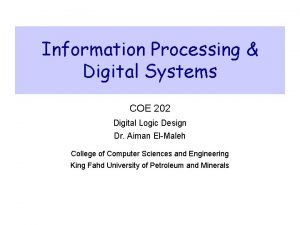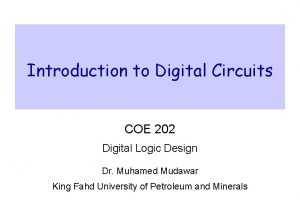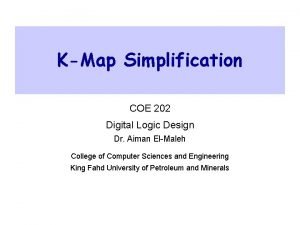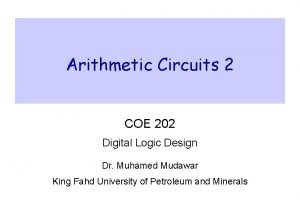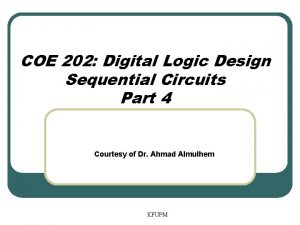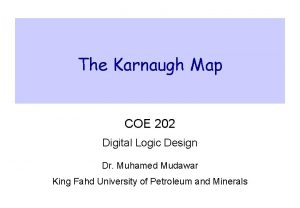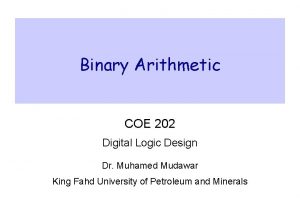Standard Canonical Forms COE 202 Digital Logic Design






























- Slides: 30

Standard & Canonical Forms COE 202 Digital Logic Design Dr. Aiman El-Maleh College of Computer Sciences and Engineering King Fahd University of Petroleum and Minerals

Outline v Minterms v Maxterms v Expressing Functions as a Sum of Minterms and Product of Maxterms v Canonical Forms v Standard Forms v Two-Level Implementations of Standard Forms v Propagation Delay Standard & Canonical Forms COE 202– Digital Logic Design – KFUPM slide 2

Min. Terms v Consider a system of 3 input signals (variables) x, y, & z. v A term which ANDs all input variables, either in the true or complement form, is called a minterm. v Thus, the considered 3 -input system has 8 minterms, namely: v Each minterm equals 1 at exactly one particular input combination and is equal to 0 at all other combinations v Thus, for example, is always equal to 0 except for the input combination xyz = 000, where it is equal to 1. v Accordingly, the minterm is referred to as m 0. v In general, minterms are designated mi, where i corresponds the input combination at which this minterm is equal to 1. Standard & Canonical Forms COE 202– Digital Logic Design – KFUPM slide 3

Min. Terms v For the 3 -input system under consideration, the number of possible input combinations is 23, or 8. This means that the system has a total of 8 minterms as follows: Standard & Canonical Forms COE 202– Digital Logic Design – KFUPM slide 4

Min. Terms v In general, for n-input variables, the number of minterms = the total number of possible input combinations = 2 n. v A minterm = 0 at all input combinations except one where the minterm = 1. v Example: What is the number of minterms for a function with 5 input variables? ² Number of minterms = 25 =32 minterms. Standard & Canonical Forms COE 202– Digital Logic Design – KFUPM slide 5

Max. Terms v Consider a circuit of 3 input signals (variables) x, y, & z. v A term which ORs all input variables, either in the true or complement form, is called a Maxterm. v With 3 -input variables, the system under consideration has a total of 8 Maxterms, namely: v Each Maxterm equals 0 at exactly one of the 8 possible input combinations and is equal to 1 at all other combinations. ² For example, (x + y + z) equals 1 at all input combinations except for the combination xyz = 000, where it is equal to 0. ² Accordingly, the Maxterm (x + y + z) is referred to as M 0. Standard & Canonical Forms COE 202– Digital Logic Design – KFUPM slide 6

Max. Terms v In general, Maxterms are designated Mi, where i corresponds to the input combination at which this Maxterm is equal to 0. v For the 3 -input system, the number of possible input combinations is 23, or 8. This means that the system has a total of 8 Maxterms as follows: Standard & Canonical Forms COE 202– Digital Logic Design – KFUPM slide 7

Max. Terms v For n-input variables, the number of Maxterms = the total number of possible input combinations = 2 n. v A Maxterm = 1 at all input combinations except one where the Maxterm = 0. v Using De-Morgan’s theorem, or truth tables, it can be easily shown that: Standard & Canonical Forms COE 202– Digital Logic Design – KFUPM slide 8

Expressing Functions as a Sum of Minterms v Consider the function F defined by the shown truth table: v Now let’s rewrite the table, with few added columns. ² A column i indicating the input combination ² Four columns of minterms m 2, m 4, m 5 and m 7 ² One last column OR-ing the above minterms (m 2+m 4+m 5+m 7) v From this table, we can clearly see that F = m 2+m 4+m 5+m 7 Standard & Canonical Forms COE 202– Digital Logic Design – KFUPM slide 9

Expressing Functions as a Sum of Minterms v In general, Any function can be expressed by OR-ing all minterms (mi) corresponding to input combinations (i) at which the function has a value of 1. v The resulting expression is commonly referred to as the SUM of minterms and is typically expressed as F = Σ(2, 4, 5, 7), where Σ indicates OR-ing of the indicated minterms. Thus, F = Σ(2, 4, 5, 7) = (m 2 + m 4 + m 5 + m 7) Standard & Canonical Forms COE 202– Digital Logic Design – KFUPM slide 10

Expressing Functions as a Sum of Minterms v Consider the example with F and F`. v The truth table of F` shows that F` equals 1 at i = 0, 1, 3 and 6, then, ² F` = m 0 + m 1 + m 3 + m 6, ² F` = Σ(0, 1, 3, 6), ² F = Σ(2, 4, 5, 7) v The sum of minterms expression of F` contains all minterms that do not appear in the sum of minterms expression of F. Standard & Canonical Forms COE 202– Digital Logic Design – KFUPM slide 11

Expressing Functions as a Product of Sums v Using De-Morgan theorem on equation: v This form is designated as the Product of Maxterms and is expressed using the Π symbol, which is used to designate product in regular algebra, but is used to designate AND-ing in Boolean algebra. v F` = Π (2, 4, 5, 7) = M 2. M 4. M 5. M 7 v F` = Σ(0, 1, 3, 6) = Π (2, 4, 5, 7) Standard & Canonical Forms COE 202– Digital Logic Design – KFUPM slide 12

Expressing Functions as Sum of Minterms or Product of Maxterms v Any function can be expressed both as a sum of minterms (Σ mi) and as a product of maxterms (Π Mj). v The product of maxterms expression (Π Mj) of F contains all maxterms Mj (∀ j ≠ i) that do not appear in the sum of minterms expression of F. v The sum of minterms expression of F` contains all minterms that do not appear in the sum of minterms expression of F. v This is true for all complementary functions. Thus, each of the 2 n minterms will appear either in the sum of minterms expression of F or the sum of minterms expression of F` but not both. Standard & Canonical Forms COE 202– Digital Logic Design – KFUPM slide 13

Expressing Functions as Sum of Minterms or Product of Maxterms v The product of maxterms expression of F` contains all maxterms that do not appear in the product of maxterms expression of F. v This is true for all complementary functions. Thus, each of the 2 n maxterms will appear either in the product of maxterms expression of F or the product of maxterms expression of F` but not both. Standard & Canonical Forms COE 202– Digital Logic Design – KFUPM slide 14

Expressing Functions as Sum of Minterms or Product of Maxterms v Example: Given that F (a, b, c, d) = Σ(0, 1, 2, 4, 5, 7), derive the product of maxterms expression of F and the two standard form expressions of F`. v Since the system has 4 input variables (a, b, c & d), the number of minterms and maxterms = 24= 16 v F (a, b, c, d) = Σ(0, 1, 2, 4, 5, 7) v F = Π (3, 6, 8, 9, 10, 11, 12, 13, 14, 15) v F` = Σ (3, 6, 8, 9, 10, 11, 12, 13, 14, 15). v F` = Π (0, 1, 2, 4, 5, 7) Standard & Canonical Forms COE 202– Digital Logic Design – KFUPM slide 15

Finding the Sum of Minterms from a Given Expression v Let F(A, B, C)= A B + A’ C, express F as a sum of minterms v F(A, B, C)= A B (C+C’) + A’ C (B+B’) v = ABC + ABC’ + A’BC + A’B’C v = Σ(1, 3, 6, 7) v Short Cut Method: ² A B = 1 1 - This gives us the input combinations 110 and 111 which correspond to m 6 and m 7 ² A’ C = 0 – 1 This gives us the input combinations 001 and 011 which correspond to m 1 and m 3 Standard & Canonical Forms COE 202– Digital Logic Design – KFUPM slide 16

Operations on Functions v The AND operation on two functions corresponds to the intersection of the two sets of minterms of the functions v The OR operation on two functions corresponds to the union of the two sets of minterms of the functions v Example ² Let F(A, B, C)=Σm(1, 3, 6, 7) and G(A, B, C)=Σm(0, 1, 2, 4, 6, 7) ² F. G = Σm(1, 6, 7) ² F + G = Σm(0, 1, 2, 3, 4, 6, 7) ² F’. G = ? ² F’ = Σm(0, 2, 4, 5) ² F’. G = Σm(0, 2, 4) Standard & Canonical Forms COE 202– Digital Logic Design – KFUPM slide 17

Canonical Forms v The sum of minterms and the product of maxterms forms of Boolean expressions are known as canonical forms. v Canonical form means that all equivalent functions will have a unique and equal representation. v Two functions are equal if and only if they have the same sum of minterms and the same product of maxterms. v Example: ² Are the functions F 1 = a' b' + a c + b c ' and F 2 = a' c' + a b + b' c Equal? ² F 1 = a' b' + a c + b c ' = Σm(0, 1, 2 , 5, 6, 7) ² F 2 = a' c' + a b + b' c = Σm(0, 1, 2 , 5, 6, 7) ² They are equal as they have the same set of minterms. Standard & Canonical Forms COE 202– Digital Logic Design – KFUPM slide 18

Standard Forms v A product term is a term with ANDed literals. Thus, AB, A’B, A’CD are all product terms. v A minterm is a special case of a product term where all input variables appear in the product term either in the true or complement form. v A sum term is a term with ORed literals. Thus, (A+B), (A’+B), (A’+C+D) are all sum terms. v A maxterm is a special case of a sum term where all input variables, either in the true or complement form, are ORed together. Standard & Canonical Forms COE 202– Digital Logic Design – KFUPM slide 19

Standard Forms v Boolean functions can generally be expressed in the form of a Sum of Products (SOP) or in the form of a Product of Sums (POS). v The sum of minterms form is a special case of the SOP form where all product terms are minterms. v The product of maxterms form is a special case of the POS form where all sum terms are maxterms. v The SOP and POS forms are Standard forms for representing Boolean functions. Standard & Canonical Forms COE 202– Digital Logic Design – KFUPM slide 20

Two-Level Implementations of Standard Forms Sum of Products Expressions (SOP): v Any SOP expression can be implemented in 2 -levels of gates. v The first level consists of a number of AND gates which equals the number of product terms in the expression. v Each AND gate implements one of the product terms in the expression. v The second level consists of a SINGLE OR gate whose number of inputs equals the number of product terms in the expression. Standard & Canonical Forms COE 202– Digital Logic Design – KFUPM slide 21

Two-Level Implementations of Standard Forms v Example: Implement the following SOP function F = XZ + Y`Z + X`YZ Standard & Canonical Forms COE 202– Digital Logic Design – KFUPM slide 22

Two-Level Implementations of Standard Forms Product of Sums Expression (POS): v Any POS expression can be implemented in 2 -levels of gates. v The first level consists of a number of OR gates which equals the number of sum terms in the expression. v Each gate implements one of the sum terms in the expression. v The second level consists of a SINGLE AND gate whose number of inputs equals the number of sum terms. Standard & Canonical Forms COE 202– Digital Logic Design – KFUPM slide 23

Two-Level Implementations of Standard Forms v Example: Implement the following POS function F = (X+Z )(Y`+Z)(X`+Y+Z ) Standard & Canonical Forms COE 202– Digital Logic Design – KFUPM slide 24

Two-Level vs. Three-Level Implementation v Standard & Canonical Forms COE 202– Digital Logic Design – KFUPM slide 25

Propagation Delay v Consider the shown inverter with input X and output Z. ² A change in the input (X) from 0 to 1 causes the inverter output (Z) to change from 1 to 0. ² The change in the output (Z), however is not instantaneous. Rather, it occurs slightly after the input change. ² This delay between an input signal change and the corresponding output signal change is what is known as the propagation delay. Standard & Canonical Forms COE 202– Digital Logic Design – KFUPM slide 26

Propagation Delay v A signal change on the input of some IC takes a finite amount of time to cause a corresponding change on the output. v This finite delay time is known as Propagation Delay. v Faster circuits are characterized by smaller propagation delays. v Higher performance systems require higher speeds (smaller propagation delays). Standard & Canonical Forms COE 202– Digital Logic Design – KFUPM slide 27

Timing Diagrams v A timing diagram shows the logic values of signals in a circuit versus time. v A signal shape versus time is typically referred to as Waveform. v Example: Standard & Canonical Forms COE 202– Digital Logic Design – KFUPM slide 28

Computing Longest Delay v Each gate has a given propagation delay. v We start at the inputs and compute the delay at the output of each gate as follows: ² The delay at the output of a gate = gate propagation delay + maximum delay at its inputs v Maximum propagation delay from any input to any output is called the Critical Path. v The critical path determines the minimum clock period (T) and the maximum clock frequency (f). v Clock frequency (f) = 1 / T Standard & Canonical Forms COE 202– Digital Logic Design – KFUPM slide 29

Computing Longest Delay v Example: Assume that delay of each gate is related to number of its inputs i. e. delay of 1 input gate is 1 ns, delay of 2 -input gate is 2 ns. Compute longest propagation delay and maximum frequency. v Longest propagation delay = 7 ns v Maximum frequency = 1 / 7 ns= 143 MHZ. Standard & Canonical Forms COE 202– Digital Logic Design – KFUPM slide 30
 Canonical form digital logic
Canonical form digital logic Canonical clause examples
Canonical clause examples Grand partition function
Grand partition function Coe 202 kfupm
Coe 202 kfupm Pos expression can be implemented using
Pos expression can be implemented using Coe 202
Coe 202 Coe 202
Coe 202 Coe 202
Coe 202 Coe 202 kfupm
Coe 202 kfupm State diagram truth table
State diagram truth table Coe 202
Coe 202 Coe 202
Coe 202 Coe 202
Coe 202 Coe 202
Coe 202 Coe 202 unlv
Coe 202 unlv Counters courtesy
Counters courtesy Coe 202
Coe 202 Canonical and standard forms
Canonical and standard forms Coe logic
Coe logic Simplex method standard form
Simplex method standard form Ashrae standard 202 pdf
Ashrae standard 202 pdf Digital logic design tutorial
Digital logic design tutorial Digital logic design number system
Digital logic design number system Digital logic design practice problems
Digital logic design practice problems Digital logic design lectures
Digital logic design lectures Digital logic design
Digital logic design First order logic vs propositional logic
First order logic vs propositional logic First order logic vs propositional logic
First order logic vs propositional logic Third order logic
Third order logic Concurrent vs sequential
Concurrent vs sequential Tw
Tw

